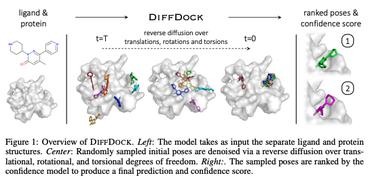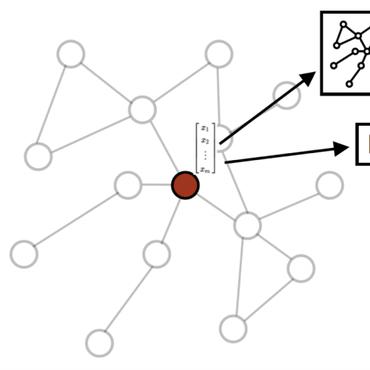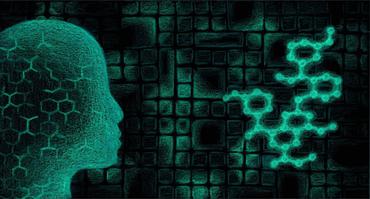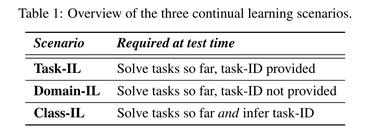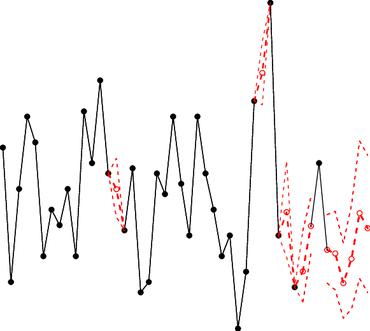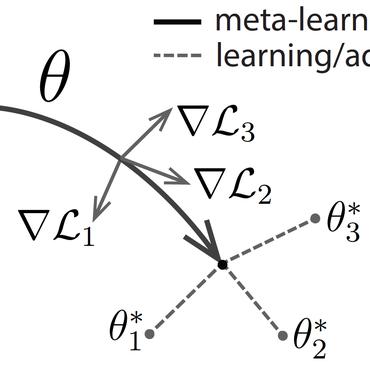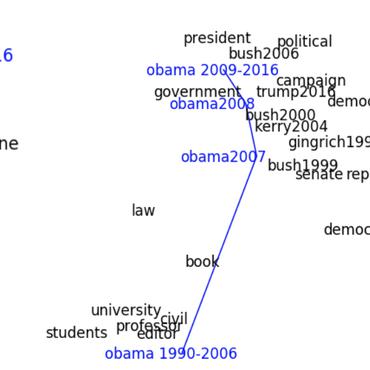Search Results for author: William L. Hamilton
Found 48 papers, 30 papers with code
Distilling Structured Knowledge for Text-Based Relational Reasoning
no code implementations • EMNLP 2020 • Jin Dong, Marc-Antoine Rondeau, William L. Hamilton
There is an increasing interest in developing text-based relational reasoning systems, which are capable of systematically reasoning about the relationships between entities mentioned in a text.
Generative Active Learning for the Search of Small-molecule Protein Binders
no code implementations • 2 May 2024 • Maksym Korablyov, Cheng-Hao Liu, Moksh Jain, Almer M. van der Sloot, Eric Jolicoeur, Edward Ruediger, Andrei Cristian Nica, Emmanuel Bengio, Kostiantyn Lapchevskyi, Daniel St-Cyr, Doris Alexandra Schuetz, Victor Ion Butoi, Jarrid Rector-Brooks, Simon Blackburn, Leo Feng, Hadi Nekoei, SaiKrishna Gottipati, Priyesh Vijayan, Prateek Gupta, Ladislav Rampášek, Sasikanth Avancha, Pierre-Luc Bacon, William L. Hamilton, Brooks Paige, Sanchit Misra, Stanislaw Kamil Jastrzebski, Bharat Kaul, Doina Precup, José Miguel Hernández-Lobato, Marwin Segler, Michael Bronstein, Anne Marinier, Mike Tyers, Yoshua Bengio
Despite substantial progress in machine learning for scientific discovery in recent years, truly de novo design of small molecules which exhibit a property of interest remains a significant challenge.
Edge-similarity-aware Graph Neural Networks
1 code implementation • 20 Sep 2021 • Vincent Mallet, Carlos G. Oliver, William L. Hamilton
For instance, the 3D structure of RNA can be efficiently represented as $\textit{2. 5D graphs}$, graphs whose nodes are nucleotides and edges represent chemical interactions.
RNAglib: A Python Package for RNA 2.5D Graphs
1 code implementation • 9 Sep 2021 • Vincent Mallet, Carlos Oliver, Jonathan Broadbent, William L. Hamilton, Jérôme Waldispühl
RNA 3D architectures are stabilized by sophisticated networks of (non-canonical) base pair interactions, which can be conveniently encoded as multi-relational graphs and efficiently exploited by graph theoretical approaches and recent progresses in machine learning techniques.
Ego-GNNs: Exploiting Ego Structures in Graph Neural Networks
no code implementations • 22 Jul 2021 • Dylan Sandfelder, Priyesh Vijayan, William L. Hamilton
Graph neural networks (GNNs) have achieved remarkable success as a framework for deep learning on graph-structured data.
NodePiece: Compositional and Parameter-Efficient Representations of Large Knowledge Graphs
4 code implementations • ICLR 2022 • Mikhail Galkin, Etienne Denis, Jiapeng Wu, William L. Hamilton
To this end, we propose NodePiece, an anchor-based approach to learn a fixed-size entity vocabulary.
 Ranked #18 on
Link Property Prediction
on ogbl-wikikg2
Ranked #18 on
Link Property Prediction
on ogbl-wikikg2
Rethinking Graph Transformers with Spectral Attention
1 code implementation • NeurIPS 2021 • Devin Kreuzer, Dominique Beaini, William L. Hamilton, Vincent Létourneau, Prudencio Tossou
Here, we present the $\textit{Spectral Attention Network}$ (SAN), which uses a learned positional encoding (LPE) that can take advantage of the full Laplacian spectrum to learn the position of each node in a given graph.
Online Adversarial Attacks
1 code implementation • ICLR 2022 • Andjela Mladenovic, Avishek Joey Bose, Hugo Berard, William L. Hamilton, Simon Lacoste-Julien, Pascal Vincent, Gauthier Gidel
Adversarial attacks expose important vulnerabilities of deep learning models, yet little attention has been paid to settings where data arrives as a stream.
Exploring the Limits of Few-Shot Link Prediction in Knowledge Graphs
no code implementations • EACL 2021 • Dora Jambor, Komal Teru, Joelle Pineau, William L. Hamilton
Real-world knowledge graphs are often characterized by low-frequency relations - a challenge that has prompted an increasing interest in few-shot link prediction methods.
Neural representation and generation for RNA secondary structures
no code implementations • ICLR 2021 • Zichao Yan, William L. Hamilton, Mathieu Blanchette
Our work is concerned with the generation and targeted design of RNA, a type of genetic macromolecule that can adopt complex structures which influence their cellular activities and functions.
GraphLog: A Benchmark for Measuring Logical Generalization in Graph Neural Networks
1 code implementation • 1 Jan 2021 • Koustuv Sinha, Shagun Sodhani, Joelle Pineau, William L. Hamilton
In this work, we study the logical generalization capabilities of GNNs by designing a benchmark suite grounded in first-order logic.
TeMP: Temporal Message Passing for Temporal Knowledge Graph Completion
1 code implementation • EMNLP 2020 • Jiapeng Wu, Meng Cao, Jackie Chi Kit Cheung, William L. Hamilton
Our analysis also reveals important sources of variability both within and across TKG datasets, and we introduce several simple but strong baselines that outperform the prior state of the art in certain settings.
Directional Graph Networks
2 code implementations • 6 Oct 2020 • Dominique Beaini, Saro Passaro, Vincent Létourneau, William L. Hamilton, Gabriele Corso, Pietro Liò
Then, we propose the use of the Laplacian eigenvectors as such vector field.
 Ranked #2 on
Node Classification
on PATTERN 100k
Ranked #2 on
Node Classification
on PATTERN 100k
Structure Aware Negative Sampling in Knowledge Graphs
no code implementations • EMNLP 2020 • Kian Ahrabian, Aarash Feizi, Yasmin Salehi, William L. Hamilton, Avishek Joey Bose
Learning low-dimensional representations for entities and relations in knowledge graphs using contrastive estimation represents a scalable and effective method for inferring connectivity patterns.
VeRNAl: Mining RNA Structures for Fuzzy Base Pairing Network Motifs
2 code implementations • 1 Sep 2020 • Carlos Oliver, Vincent Mallet, Pericles Philippopoulos, William L. Hamilton, Jerome Waldispuhl
State of the art methods solve special cases of the motif problem by constraining the structural variability in occurrences of a motif, and narrowing the substructure search space.
Adversarial Example Games
1 code implementation • NeurIPS 2020 • Avishek Joey Bose, Gauthier Gidel, Hugo Berard, Andre Cianflone, Pascal Vincent, Simon Lacoste-Julien, William L. Hamilton
We introduce Adversarial Example Games (AEG), a framework that models the crafting of adversarial examples as a min-max game between a generator of attacks and a classifier.
Exploring the Limits of Simple Learners in Knowledge Distillation for Document Classification with DocBERT
no code implementations • WS 2020 • Ashutosh Adhikari, Achyudh Ram, Raphael Tang, William L. Hamilton, Jimmy Lin
Fine-tuned variants of BERT are able to achieve state-of-the-art accuracy on many natural language processing tasks, although at significant computational costs.
Learning an Unreferenced Metric for Online Dialogue Evaluation
1 code implementation • ACL 2020 • Koustuv Sinha, Prasanna Parthasarathi, Jasmine Wang, Ryan Lowe, William L. Hamilton, Joelle Pineau
Evaluating the quality of a dialogue interaction between two agents is a difficult task, especially in open-domain chit-chat style dialogue.
Evaluating Logical Generalization in Graph Neural Networks
1 code implementation • ICML Workshop LifelongML 2020 • Koustuv Sinha, Shagun Sodhani, Joelle Pineau, William L. Hamilton
Recent research has highlighted the role of relational inductive biases in building learning agents that can generalize and reason in a compositional manner.
Learning Dynamic Belief Graphs to Generalize on Text-Based Games
1 code implementation • NeurIPS 2020 • Ashutosh Adhikari, Xingdi Yuan, Marc-Alexandre Côté, Mikuláš Zelinka, Marc-Antoine Rondeau, Romain Laroche, Pascal Poupart, Jian Tang, Adam Trischler, William L. Hamilton
Playing text-based games requires skills in processing natural language and sequential decision making.
Latent Variable Modelling with Hyperbolic Normalizing Flows
1 code implementation • ICML 2020 • Avishek Joey Bose, Ariella Smofsky, Renjie Liao, Prakash Panangaden, William L. Hamilton
One effective solution is the use of normalizing flows \cut{defined on Euclidean spaces} to construct flexible posterior distributions.
Structural Inductive Biases in Emergent Communication
no code implementations • 4 Feb 2020 • Agnieszka Słowik, Abhinav Gupta, William L. Hamilton, Mateja Jamnik, Sean B. Holden, Christopher Pal
In order to communicate, humans flatten a complex representation of ideas and their attributes into a single word or a sentence.
Towards Graph Representation Learning in Emergent Communication
no code implementations • 24 Jan 2020 • Agnieszka Słowik, Abhinav Gupta, William L. Hamilton, Mateja Jamnik, Sean B. Holden
Recent findings in neuroscience suggest that the human brain represents information in a geometric structure (for instance, through conceptual spaces).
Meta-Graph: Few Shot Link Prediction via Meta Learning
1 code implementation • 20 Dec 2019 • Avishek Joey Bose, Ankit Jain, Piero Molino, William L. Hamilton
We consider the task of few shot link prediction on graphs.
Inductive Relation Prediction by Subgraph Reasoning
9 code implementations • ICML 2020 • Komal K. Teru, Etienne Denis, William L. Hamilton
The dominant paradigm for relation prediction in knowledge graphs involves learning and operating on latent representations (i. e., embeddings) of entities and relations.
Efficient Graph Generation with Graph Recurrent Attention Networks
2 code implementations • NeurIPS 2019 • Renjie Liao, Yujia Li, Yang Song, Shenlong Wang, Charlie Nash, William L. Hamilton, David Duvenaud, Raquel Urtasun, Richard S. Zemel
Our model generates graphs one block of nodes and associated edges at a time.
CLUTRR: A Diagnostic Benchmark for Inductive Reasoning from Text
5 code implementations • IJCNLP 2019 • Koustuv Sinha, Shagun Sodhani, Jin Dong, Joelle Pineau, William L. Hamilton
The recent success of natural language understanding (NLU) systems has been troubled by results highlighting the failure of these models to generalize in a systematic and robust way.
Neural Transfer Learning for Cry-based Diagnosis of Perinatal Asphyxia
no code implementations • 24 Jun 2019 • Charles C. Onu, Jonathan Lebensold, William L. Hamilton, Doina Precup
Despite continuing medical advances, the rate of newborn morbidity and mortality globally remains high, with over 6 million casualties every year.
Generalizable Adversarial Attacks with Latent Variable Perturbation Modelling
no code implementations • 26 May 2019 • Avishek Joey Bose, Andre Cianflone, William L. Hamilton
Adversarial attacks on deep neural networks traditionally rely on a constrained optimization paradigm, where an optimization procedure is used to obtain a single adversarial perturbation for a given input example.
Compositional Fairness Constraints for Graph Embeddings
1 code implementation • 25 May 2019 • Avishek Joey Bose, William L. Hamilton
Learning high-quality node embeddings is a key building block for machine learning models that operate on graph data, such as social networks and recommender systems.
Compositional Language Understanding with Text-based Relational Reasoning
2 code implementations • 7 Nov 2018 • Koustuv Sinha, Shagun Sodhani, William L. Hamilton, Joelle Pineau
Neural networks for natural language reasoning have largely focused on extractive, fact-based question-answering (QA) and common-sense inference.
Weisfeiler and Leman Go Neural: Higher-order Graph Neural Networks
1 code implementation • 4 Oct 2018 • Christopher Morris, Martin Ritzert, Matthias Fey, William L. Hamilton, Jan Eric Lenssen, Gaurav Rattan, Martin Grohe
We show that GNNs have the same expressiveness as the $1$-WL in terms of distinguishing non-isomorphic (sub-)graphs.
 Ranked #4 on
Graph Classification
on NCI1
Ranked #4 on
Graph Classification
on NCI1
Deep Graph Infomax
11 code implementations • ICLR 2019 • Petar Veličković, William Fedus, William L. Hamilton, Pietro Liò, Yoshua Bengio, R. Devon Hjelm
We present Deep Graph Infomax (DGI), a general approach for learning node representations within graph-structured data in an unsupervised manner.
 Ranked #49 on
Node Classification
on Citeseer
Ranked #49 on
Node Classification
on Citeseer
Hierarchical Graph Representation Learning with Differentiable Pooling
14 code implementations • NeurIPS 2018 • Rex Ying, Jiaxuan You, Christopher Morris, Xiang Ren, William L. Hamilton, Jure Leskovec
Recently, graph neural networks (GNNs) have revolutionized the field of graph representation learning through effectively learned node embeddings, and achieved state-of-the-art results in tasks such as node classification and link prediction.
 Ranked #1 on
Graph Classification
on REDDIT-MULTI-12K
Ranked #1 on
Graph Classification
on REDDIT-MULTI-12K
Graph Convolutional Neural Networks for Web-Scale Recommender Systems
5 code implementations • 6 Jun 2018 • Rex Ying, Ruining He, Kai-Feng Chen, Pong Eksombatchai, William L. Hamilton, Jure Leskovec
We develop a data-efficient Graph Convolutional Network (GCN) algorithm PinSage, which combines efficient random walks and graph convolutions to generate embeddings of nodes (i. e., items) that incorporate both graph structure as well as node feature information.
Embedding Logical Queries on Knowledge Graphs
5 code implementations • NeurIPS 2018 • William L. Hamilton, Payal Bajaj, Marinka Zitnik, Dan Jurafsky, Jure Leskovec
Learning low-dimensional embeddings of knowledge graphs is a powerful approach used to predict unobserved or missing edges between entities.
 Ranked #6 on
Complex Query Answering
on FB15k-237
Ranked #6 on
Complex Query Answering
on FB15k-237
Community Interaction and Conflict on the Web
no code implementations • 9 Mar 2018 • Srijan Kumar, William L. Hamilton, Jure Leskovec, Dan Jurafsky
Here we study intercommunity interactions across 36, 000 communities on Reddit, examining cases where users of one community are mobilized by negative sentiment to comment in another community.
GraphRNN: Generating Realistic Graphs with Deep Auto-regressive Models
3 code implementations • ICML 2018 • Jiaxuan You, Rex Ying, Xiang Ren, William L. Hamilton, Jure Leskovec
Modeling and generating graphs is fundamental for studying networks in biology, engineering, and social sciences.
Representation Learning on Graphs: Methods and Applications
no code implementations • 17 Sep 2017 • William L. Hamilton, Rex Ying, Jure Leskovec
Machine learning on graphs is an important and ubiquitous task with applications ranging from drug design to friendship recommendation in social networks.
Inductive Representation Learning on Large Graphs
18 code implementations • NeurIPS 2017 • William L. Hamilton, Rex Ying, Jure Leskovec
Low-dimensional embeddings of nodes in large graphs have proved extremely useful in a variety of prediction tasks, from content recommendation to identifying protein functions.
 Ranked #1 on
Link Property Prediction
on ogbl-ddi
Ranked #1 on
Link Property Prediction
on ogbl-ddi
Community Identity and User Engagement in a Multi-Community Landscape
no code implementations • 26 May 2017 • Justine Zhang, William L. Hamilton, Cristian Danescu-Niculescu-Mizil, Dan Jurafsky, Jure Leskovec
To this end we introduce a quantitative, language-based typology reflecting two key aspects of a community's identity: how distinctive, and how temporally dynamic it is.
Loyalty in Online Communities
1 code implementation • 9 Mar 2017 • William L. Hamilton, Justine Zhang, Cristian Danescu-Niculescu-Mizil, Dan Jurafsky, Jure Leskovec
In this paper we operationalize loyalty as a user-community relation: users loyal to a community consistently prefer it over all others; loyal communities retain their loyal users over time.
Inducing Domain-Specific Sentiment Lexicons from Unlabeled Corpora
1 code implementation • EMNLP 2016 • William L. Hamilton, Kevin Clark, Jure Leskovec, Dan Jurafsky
A word's sentiment depends on the domain in which it is used.
Cultural Shift or Linguistic Drift? Comparing Two Computational Measures of Semantic Change
no code implementations • EMNLP 2016 • William L. Hamilton, Jure Leskovec, Dan Jurafsky
Words shift in meaning for many reasons, including cultural factors like new technologies and regular linguistic processes like subjectification.
Diachronic Word Embeddings Reveal Statistical Laws of Semantic Change
4 code implementations • ACL 2016 • William L. Hamilton, Jure Leskovec, Dan Jurafsky
Understanding how words change their meanings over time is key to models of language and cultural evolution, but historical data on meaning is scarce, making theories hard to develop and test.
Efficient Learning and Planning with Compressed Predictive States
no code implementations • 1 Dec 2013 • William L. Hamilton, Mahdi Milani Fard, Joelle Pineau
Predictive state representations (PSRs) offer an expressive framework for modelling partially observable systems.


